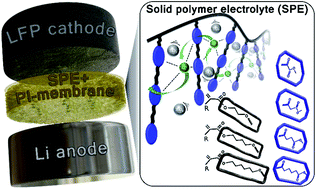Solid polymer electrolytes from polyesters with diester sidechains for lithium metal batteries†
Abstract
A series of polymethacrylates and polyacrylates carrying diester sidechain moieties with varying alkyl spacer lengths are designed, synthesized, and evaluated as solid polymer electrolytes (SPEs) in lithium metal batteries (LMBs). These amorphous polymers with glass transition temperatures in the range of −58 to +32 °C are tested as SPEs in combination with LiTFSI or LiFSI. At an optimum salt concentration of 25 wt%, ionic conductivities up to 10−4 S cm−1 at 70 °C are achieved. These SPEs reveal high lithium transport numbers (0.5–0.7) and high electrochemical stability (5.4 V vs. Li/Li+) as determined by LSV. In combination with an ultrathin polyimide membrane and 10 wt% TiO2 nanoparticles, dendrite-free plating/stripping at 40 and 70 °C is realized in symmetrical Li|SPE|Li cells. Detailed extended distribution of relaxation times (eDRT) analysis of impedance measurements is employed for understanding the diverse cell processes. In solvent-free LMBs comprising a polyimide membrane soaked with the nanocomposite polyester electrolyte, lithium metal foil as the anode and an optimized LiFePO4 cathode, a very high initial specific discharge capacity of 152 mA h g− 1 (at 0.2C, 70 °C), excellent capacity retention of 94% after 100 cycles (at 1C, 70 °C) and negligible capacity fading even at 2C (96% retention after 300 cycles) are demonstrated. These novel polyester-based SPEs exhibit high cycling stability at 40 °C, making them highly attractive for room temperature applications.



 Please wait while we load your content...
Please wait while we load your content...